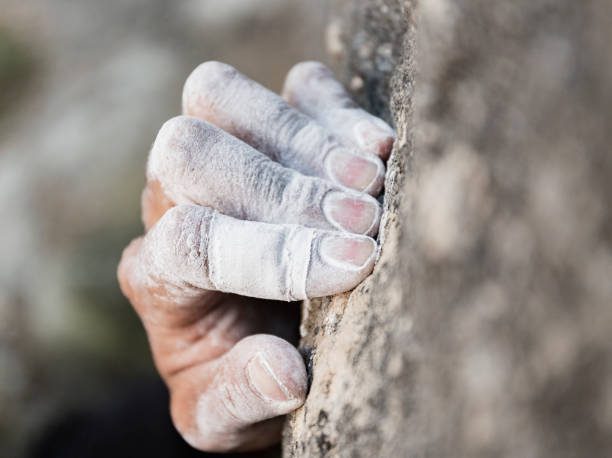Last Updated on November 10, 2022 by tawhid
Climbing chalk is a fine powder that is used to keep your hands dry while climbing. It is made of magnesium carbonate, which is a white mineral that is found in nature. The majority of commercial climbing chalk is mined in China and Pakistan.
Climbing chalk is a necessity for anyone who wants to enjoy the sport of rock climbing. But what exactly is climbing chalk made of?
The main ingredient in climbing chalk is magnesium carbonate, which is also known as “chalk dust”.
Magnesium carbonate is a white powder that absorbs moisture and helps to keep your hands dry while you’re climbing. It’s also very fine, so it doesn’t cake up on your skin or clothing like some other types of powders can.
In addition to magnesium carbonate, climbing chalk usually contains some other ingredients like calcium carbonate, kaolin clay, and talc.
These ingredients help to absorb excess moisture and improve the overall texture of the chalk so that it goes on smoothly and evenly.
While the exact recipe varies from brand to brand, most climbing chalks contain between 70-80% magnesium carbonate. So if you’re looking for a high-quality chalk that will help you climb your best, be sure to check the label to see how much magnesium carbonate it contains.

Credit: gripped.com
Is Climbing Chalk Different from Regular Chalk?
Climbing chalk is a type of magnesium carbonate that is used by climbers to dry their hands and improve their grip. It is different from regular chalk in several ways. First, climbing chalk is more finely ground, so it can better absorb moisture.
Second, climbing chalk is often mixed with other ingredients such as kaolin clay or essential oils to provide additional benefits such as increased friction or improved smell. Finally, some brands of climbing chalk are designed to leave less of a mess when applied to surfaces such as rock faces.
Is Climbing Chalk Dust Harmful?
Climbing chalk is used to absorb sweat and improve grip, however some people are concerned about the health effects of inhaling the dust.
So, is climbing chalk harmful?
The main ingredient in climbing chalk is magnesium carbonate, which is a relatively harmless substance.
However, when it is pulverized into a fine powder, it can be breathed in and irritate the lungs. Inhaling large amounts of chalk dust can cause coughing and difficulty breathing. Some studies have also shown that it can lead to inflammation of the airways and lung tissue damage.
While there is no definitive proof that climbing chalk is harmful, it is always best to use it in well-ventilated areas and avoid breathing in the dust. If you are concerned about the health effects of climbing chalk, talk to your doctor before using it.
How Do You Make Climbing Chalk at Home?
Climbing chalk is a necessity for anyone who wants to prevent their hands from sweating while they climb. Although you can purchase climbing chalk at most sporting goods stores, it’s also possible to make your own. Here’s how:
You’ll need:
– 1 cup of magnesium carbonate
– A coffee grinder or food processor
– A fine mesh strainer
– A bowl
-Optional: essential oils for scent (eucalyptus oil is particularly refreshing)
Directions:
1. Add the magnesium carbonate to the coffee grinder or food processor and grind into a powder.
2. If using essential oils, add them now and mix well.
3. Place the strainer over the bowl and pour in the powder. Tap the strainer lightly so that all of the powder falls through.
4. Store the climbing chalk in an airtight container until ready to use.
Is Climbing Chalk Talc?
Chalk is a soft, white, porous sedimentary rock, a form of limestone composed of the mineral calcite. Calcite is derived from the Latin word calx meaning lime. Chalk is predominantly biogenic, meaning it is formed by the accumulation of the remains of marine organisms such as foraminifera and coccolithophores.
Talc is a clay mineral composed of hydrated magnesium silicate with the chemical formula Mg3Si4O10(OH)2. Talc occurs in metamorphic rocks throughout the world and has been used by humans for centuries as both an ingredient in cosmetics and as a carving material.
So, are climbing chalk and talc the same thing?
The answer is no. Although both chalk and talc are minerals that occur naturally in metamorphic rocks, they have different chemical compositions and therefore are not identical substances.
Homemade Magnesium Carbonate VS Professional climbing chalk
Magnesium Carbonate Chalk Health Risks
As a dietary supplement, magnesium carbonate is used to treat indigestion. It is also used as an antacid to relieve heartburn, sour stomach, or acid indigestion. Magnesium carbonate is available without a doctor’s prescription.
Magnesium carbonate might have some side effects. Stop using magnesium carbonate and call your healthcare provider at once if you have: severe stomach pain; diarrhea that is watery or bloody; or feeling like you might pass out.
Call your doctor for medical advice about side effects.
You may report side effects to the FDA at 1-800-FDA-1088.
Conclusion
Climbing chalk is made of magnesium carbonate, which is a type of salt. It’s found in nature as a mineral called nesquehonite. Climbing chalk is used to keep your hands dry when you’re rock climbing or bouldering.
It absorbs sweat and prevents it from making your hands slippery.
